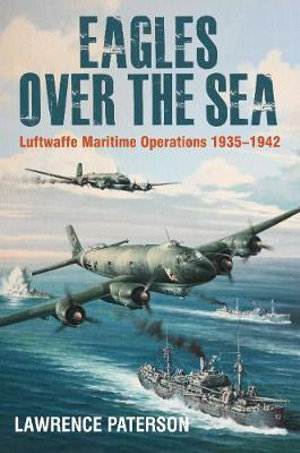
Eagles Over the Sea 1935-1942: A History of Luftwaffe Maritime Operations. By Lawrence Paterson. Pen and Sword, Barnsley, 2019.
Reviewed by Darren Puttock
Since the end of World War II in 1945 there has been an enormous amount of academic research, historical discussions and books dedicated to the German Luftwaffe. Studies of aircraft, analysis of tactics, profiles of leadership and exploration of famous air campaigns are readily available; however, until Lawrence Patterson’s book Eagles over the Sea 1935-1942, Luftwaffe maritime operations have featured only as comprehensive aircraft studies or sections of wider Luftwaffe writings. Eagles over the Seacorrects this oversight and provides the reader with detailed insights into Luftwaffe maritime operations.
Perhaps one of the reasons Luftwaffe maritime operations are often overlooked is the lack of significant victories featuring maritime aircraft, such as sinking of the Bismarck or the Battle of Midway. Yet Eagles over the Sea reveals that German aircraft featured prominently across the global theatre of operations in the maritime environment. The book covers the origins of German naval aviation, the lessons learned during the Spanish Civil War, Norway and western Europe, the Battle of the Atlantic, the Mediterranean and Eastern Front and the Arctic. The chapters are expansive and cover a chronological narrative through distinct theatres, though Patterson weaves themes across all chapters—such as the continuous frustrations associated with lack of cooperation between Luftwaffe and Kriegsmarine leadership. This instalment covers 1935-1942, as the author admits that the study is far too expansive to cover in just one volume; therefore, a second volume will follow in due course.
One of the features of the book are anecdotes recounting actions involving maritime aircraft. This includes the tragedy of the sinking of the destroyer Lebrecht Maass, known as the “Wikinger Disaster”, as a convoy of six destroyers made its way through the safe channel in a German minefield. Due to misidentification, poor communication and lack of basic protocols, such as exchanging recognition signals, the Lebrecht Maass was sunk by bombs dropped from a KG 26 He 111 during several attack runs. During the tragic action the German destroyer Max Schulz was also sunk, though it has never been conclusively determined what caused the loss of second destroyer. In total, 578 men were killed. Patterson’s recount of the disaster includes timelines, post-action reports from KG 26, and the findings of the joint Luftwaffe-Kriegsmarine enquiry. His narrative and analysis offer a careful study of the struggles related to the abject failure of naval and air units to effectively coordinate. This is just one of countless examples in the book that allow the reader to fully understand the ponderous evolution of Luftwaffe maritime operations.
Those familiar with German military operations in the Second World War will have undoubtedly read of the power struggles within the Third Reich. Decisions were based on narcissism and ego, with blatant disregard for the operational effects of personal myopia. Through his desire for personal power and prestige, the Luftwaffe suffered continuously under its leader, Hermann Göring. Patterson carefully interlaces this throughout his recounting of the birth and growth of Luftwaffe maritime operations. Modern military members can readily see how lack of cooperation between naval and air units compromises operational outcomes. Patterson will likely surprise readers with the scale of success achieved by Fw 200 Condors against Allied vessels despite their limited numbers and continuous serviceability issues; however, through memorandums, dispatches, anecdotes and historical narrative, it is very clear that German success in the maritime domain was hindered by bitter personal rivalries between Luftwaffe and Kriegsmarine leadership.
Lawrence Patterson has obviously dedicated a vast amount of research into writing Eagles over the Sea, for the book is extremely detailed and comprehensive. Immediately after the acknowledgements is the glossary. This is extensive and situates the reader by explaining German terminology: rank equivalents between Luftwaffe, Kriegsmarine and RAF/USAAF; operational and tactical organisational notes to explain unit structure and Luftwaffe unit and aircraft identification methodologies. Details such as aircraft development and tactics, directives and orders, unit details and composition, profiles of notable people and accounts of operations all feature throughout. The book contains numerous illustrations, many of which this reviewer has not seen previously. Some of the more interesting photos are from the personal album of an unidentified Luftwaffe Leutnant who was a He 115 pilot in the propaganda film Kampfgeschwader Lützow. As a final touch, the index will also appeal greatly to researchers as it is sub-categorised into people, Luftwaffe units, naval ships, U-boats, and merchant ships.
This book presents an impressive amount of detail which dedicated researchers will find authoritative yet is also very readable to more casual readers who are interested in understanding an aspect of German Luftwaffe operations previously overlooked by historians. I highly recommend this book and believe it strongly deserves your consideration.




Thank you for the kind words Mister Puttock.
Cheers